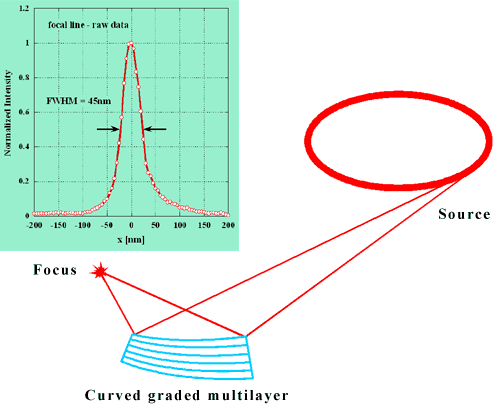- Home
- News
- Spotlight on Science
- 40 nm Focus Reached...
40 nm Focus Reached at the ESRF using Dynamically-bent Graded Multilayers
30-09-2005
Focusing hard X-rays efficiently down to spots below 100 nm is a real challenge for presently-available X-ray optics. Among various other techniques, curved and laterally graded multilayers are promising candidates to provide the required performance, thanks to their potentially large numerical aperture. In recent focusing experiments on the ESRF beamline ID19 a focal line width below 50 nm was achieved.
Share
The result was obtained using a dynamically-bent [W/B 4C] 25 graded multilayer in vertical reflection which was exposed to the full ID19 undulator line at 24 keV (Figure 1). The bending technology, the multilayer coating, and the detection setup are ESRF in-house developments.
 |
|
Fig. 1: Simplified focusing scheme and scan through the focal line (raw data). |
The multilayer was placed at 150 m from the source and produced a focal line at a distance of 8 cm. The strong demagnification of 1/1875 together with the small vertical source size of 25 µm would lead to a geometrical line width of only 13 nm. This permits the investigation of line broadening effects due to diffraction, slope errors, and volume scattering.
The focal line was scanned using a lithographically prepared Ru nano-wire under grazing incidence while detecting the fluorescent radiation. The dimensions of the wire are well known and can therefore be taken into account in the data analysis. Best values for the focal line are 41 nm FWHM after de-convolution and with an aperture of about 130 µm. This is the smallest width ever reported using reflective multilayer optics for hard X-rays.
The measured focal size is mainly limited by diffraction and mirror figure errors, which become predominant when a larger portion of the mirror is used to decrease the diffraction influence. Stability tests based on the position of the focal line show that mechanical vibrations remain a principle obstacle for the detection of smaller spots.
To investigate the influence of volume penetration effects in the multilayer the photon energy of the incident beam was modified by opening the undulator gap. The wide energy bandpass of the multilayer (about 9%) allows scanning the undulator line through the 1st Bragg peak, leading to a strong variation of the penetration depth of the electromagnetic field into the multilayer. Unlike in the case of curved crystals, the curved and graded multilayer structure fulfils the local Bragg condition at any point along the optics. Therefore, no additional contribution to the line width has been observed.
Authors
O. Hignette, P. Cloetens, Ch. Morawe, P. Bernard, W. Ludwig, ESRF



